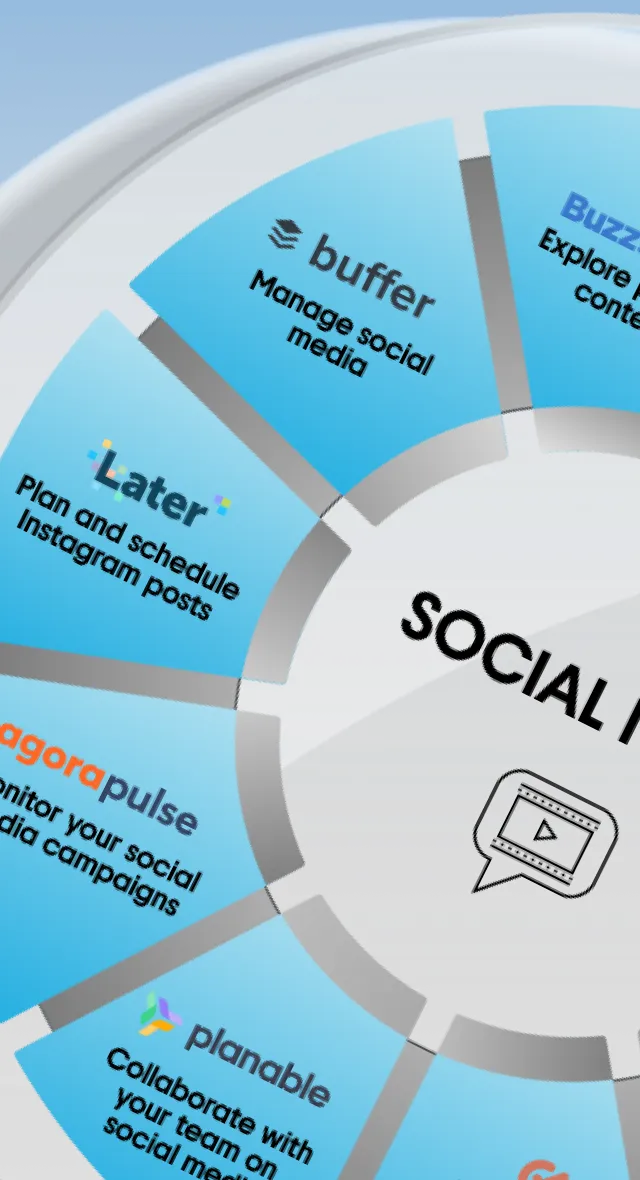Mastering B2B Market Research: Proven Strategies for Success
As the B2B market is constantly in flux and affected by many factors, it’s important to keep your finger on the pulse to stay competitive and boost your business performance. What do your potential customers need? Will your new product be successful? How can you increase your business profitability? These are just a few questions to answer by conducting B2B market research.
You’ve likely already tried different strategies, but are they the best options? To help you find answers, we’ve created a guide to the main B2B market research methods, describing their essentials, advantages, and disadvantages. So, let’s get to the point!
What is B2B market research?
Let’s start with the basics. B2B market research systematically collects, analyzes, and interprets data about the market, target customers, competitors, and other elements impacting a business’s performance. It’s a major component of a marketing strategy and a mandatory step before making strategic business decisions. Simply put, B2B market research allows you to get a comprehensive picture of the current state of the market and choose a development vector following it.
The terms “B2B market research” and “B2B market analysis” are often used interchangeably, but they differ in purpose and results. Market research aims to gather new information to address particular questions, such as which product to launch or how to position it. In contrast, market analysis uses existing data to assess market opportunities and trends: how the market grows; which segments are most promising; what are the barriers to entry, etc.
We’ve covered the general purpose of B2B market research, so let’s shift to more specific goals that you can achieve with this approach.
The main objectives and benefits of B2B market research
- Understanding customer needs. Market research allows you to identify problems or customer desires that your product or service can address. It also gives a better idea of audience expectations regarding price, quality, and features.
- Market evaluation. You will gain a clear picture of the total addressable market (TAM), serviceable market, and market share opportunities.
- Competitive analysis. Analyzing competitors’ products, pricing, marketing strategies, strengths, and weaknesses allows you to find competitive advantages and stand out in the market.
- Data-driven product development. With B2B market research, you can identify features most valued by your potential clients and evaluate new product ideas or prototypes before launch.
- Improving marketing strategies. Another benefit is finding the right messages, channels, and value propositions to reach target customers.
- Assessment of customer satisfaction. Customer feedback shows areas for product or service improvement and helps you understand why clients stay with your brand or choose competitors.
- Defining risks and opportunities. B2B market research reveals potential obstacles to growth and factors that can negatively affect the business. At the same time, it identifies underestimated niches and unmet needs.
- Strategic planning. You can assess the possibilities of entering new markets, and attracting investments and partnerships.
Given this vast array of possibilities, you’re probably eager to start. But first, let’s clarify the features and differences between various research methods so that you can choose the best approach to fit your business goals, budget, and timeframe.
Key categories of B2B market research
We start with a general classification that divides B2B market research types into primary and secondary. Each strategy we’ll describe further belongs to one of these categories. So how do they differ?
Primary research
Primary research implies collecting data directly from the market through surveys, observations, or experiments. This type of research provides up-to-date information adjusted to company needs, but requires significant time and financial resources. Businesses can either perform study on their own or hire intermediaries.
Primary research is usually conducted to solve a specific problem requiring in-depth analysis. The main advantage is that it allows you to learn about the needs and preferences of target customers firsthand. It’s also a reliable way to identify competitors accurately.
Primary B2B market research methods:
- Interviews
- Surveys
- Focus groups
- Experiments
Secondary research
Secondary research is based on analyzing existing data, such as reports, statistics, articles, and studies conducted by other organizations. This approach provides instant results. Professionals have already processed the data in the reports and shown correlations between facts and operations. In addition, information for secondary research is often easy to find.
This method is cheaper and faster than primary research, but may be less accurate and up-to-date. In addition, the quality and reliability of such data require thorough verification, which is not always possible.
Types of secondary B2B market research:
- Industry reports
- Data analysis
- Social listening
- Competitive analysis
In addition to primary and secondary, B2B market research methods are categorized into qualitative and quantitative.
Qualitative research
These methods aim to deepen your understanding of consumers’ motivations, decisions, and perceptions. They include focus groups, in-depth interviews, and observations. Qualitative research helps identify hidden needs and preferences and understand consumers’ emotional reactions to specific products or services.
Quantitative research
Unlike qualitative methods, quantitative methods focus on collecting data in numerical terms. They allow you to assess the scale of things, such as purchase frequency, market share, or customer satisfaction. Examples of quantitative methods include surveys, questionnaires, and statistical data analysis.
7 powerful strategies for B2B market research success
1. Surveys
Surveys are the most popular quantitative B2B market research method. According to Statista, 85% of industry professionals use online surveys. A survey is a list of closed-ended or open-ended questions (or a mix of both) sent to a group of people. The simplest example of such a strategy is a customer satisfaction survey—they are asked to complete after receiving a certain service. In addition to online, surveys can also be conducted offline, via phone, SMS, or email.
Surveys are a versatile approach that enables businesses to gather first-hand information about a specific issue and receive valuable feedback. In particular, surveys can be used to measure brand awareness, obtain demographic data and segment the market, assess customer loyalty, identify competitors, and more.
✔️ Survey pros: low cost, ease of organizing, relatively fast method, large sample size
❌ Survey cons: sampled data, survey fatigue, inaccuracies in answers, measurement errors
💡 Pro tip. Keep questions short and precise. Ensure they don’t impose a specific answer to get the most objective picture possible. Include no more than 10 questions in the survey to avoid taking up too much of your respondents’ time.
2. Interviews
In-depth interviews are qualitative B2B market research methods conducted as personal conversations between an interviewer and a purposefully selected respondent from the target audience. Respondents are interviewed separately, and their answers are recorded. Unlike surveys, interviews only consist of open-ended questions. They allow you to ask more complex questions and get more honest and insightful answers.
In-depth interviews can focus on a problem (to understand the pain points of your target customers), a product (to understand whether your product solves the customer’s problem), or expert opinion (to gain expert insights from industry professionals). Interviewing is a powerful method of narrative research. It allows you to create buyer personas, draw different scenarios of the customer journey map, and analyze business processes affecting their satisfaction with the product.
✔️ In-depth interview pros: high quality of sampling, candid detailed responses, deep insights, flexibility
❌ In-depth interview cons: time- and resource-consuming, risk of biases, limited generalizability, analysis complexity
💡 Pro tip. Plan interviews to last 30-60 minutes—it’ll give you enough time. Ask follow-up questions to elicit detailed answers and use active listening to show your interest and motivate respondents to express themselves openly.
3. Focus groups
A focus group is another type of qualitative B2B customer research. It is an interview conducted as a discussion with a small group of respondents with similar characteristics (from 6 to 12 people). Unlike an in-depth interview, the discussion in a focus group is primarily between the respondents, and the researcher only moderates the conversation. The talk is targeted, and the topic is determined in advance.
The fact that focus group participants are free to communicate and express their opinions allows you to get a detailed picture of consumer perceptions and look at issues from new, unexpected angles. It is an efficient way to evaluate brand perception, product concept, or marketing communication. Such a discussion can bring up fresh ideas you’ve never considered before.
✔️ Focus group pros: valuable insights, wide range of opinions, real-time feedback, emotional connections
❌ Focus group cons: limited sample size, difficulties in engaging participants, dominant voices, analysis complexity
💡 Pro tip. Consider conducting online focus groups via videoconferencing tools to expand the geographic reach of participants and save time and effort for everyone involved. This format also provides psychological comfort to respondents, as they can join the discussion from a familiar environment.
4. Social listening
Modern social media is a powerhouse tool not only for business expansion and building a brand community, but also for conducting B2B market research. Social listening refers to tracking mentions of your brand or competitors and the latest industry trends. By analyzing thematic discussions on LinkedIn or Facebook pages and niche groups, you can gain valuable insights and better understand your target customers’ sentiments.
Social listening is a great way to collect honest feedback about your product or service, its advantages and disadvantages, and discover improvement opportunities. This strategy also helps to identify customer pain points that are not always evident in standard feedback channels. Not to forget about tracking trends, as social media is where they arise. By following emerging trends, brands can stay ahead of their competition with products that meet the most up-to-date customer expectations.
✔️ Social listening pros: honest opinions, real-time insights, cost-free, organic engagement
❌ Social listening cons: data overload, time consumption, privacy concerns, misinterpretation of sentiments
💡 Pro tip. To save time, focus on platforms where you are more likely to find valuable information. While feedback and thematic discussions can appear on different social media platforms, since we’re focusing on B2B audiences, LinkedIn is the most promising place to start. You can also use social listening tools like Sprout Social or BuzzSumo to automate your monitoring.
Want to know more about the topic? Check out our article “Why Does Social Listening Matter? Definitions, Benefits, and Tips.”
5. Competitive analysis
To develop a solid business development strategy, it’s vital to clearly understand who the leading players in your niche are, how your offerings differ, what they do better, and what they do worse. This is where competitive analysis comes in. It’s one of the first steps you should take when entering a new market, launching a product, or going through a significant industry change.
With competitive analysis, you can develop your unique selling proposition, i.e., a distinctive feature that will set your product apart in the market and make it appealing to potential customers. Don’t limit yourself to just products. Analyze competitors’ marketing strategies, campaigns, and messages across different channels—the more information you gather, the easier it will be to find opportunities for differentiation.
✔️ Competitive analysis pros: understanding customer preferences, benchmarking performance, identifying growth opportunities, better decision-making
❌ Competitive analysis cons: resource consumption, limited data, short-term focus, overemphasis on competitors
💡 Pro tip. Use the insights from competitive analysis to develop a proactive rather than reactive strategy. For a well-rounded picture, supplement your findings with a SWOT analysis detailing the Strengths, Weaknesses, Opportunities, and Threats to your brand or product.
6. Research panel
Panel studies are among the primary B2B market research methods that involve collecting data from one group of respondents over a long period. It allows you to analyze the state and dynamics of their needs, challenges, motivations, etc. Panel studies focus on a clearly defined topic and rely on techniques such as surveys, interviews, or focus groups.
B2B panels bring together business representatives, companies, or decision-makers. They can help you better understand business strategies, industry trends, and target customer behavior. Research panels are particularly beneficial for market segmentation, product development, and assessing brand perception.
✔️ Research panel pros: representative sample, high efficiency, reliable data, flexibility in study types
❌ Research panel cons: high setup costs, difficulties in attracting participants, limited generalizability, risk of bias
💡 Pro tip: One key challenge in arranging B2B research panels is finding relevant respondents. To overcome this, use LinkedIn’s potential by setting up automated messages targeting specific job titles.
7. Product testing
Product testing is market research that enables businesses to gather valuable information about potential consumer behavior and product perception. The product itself can be either a consumer good or a service. The point is that you provide your product or its prototype for testing to target customers in exchange for detailed feedback. This way, you can get a complete picture of the product’s strengths and weaknesses from the end user’s perspective.
The main advantage of product testing is that it reduces the likelihood of failure, as you identify flaws early and can eliminate them without significant costs. It’s not just about high quality; it’s about creating a product that truly meets customers’ needs and expectations. A well-tested product is more likely to win the target audience’s hearts.
✔️ Product testing pros: detailed feedback from real users, cost-efficiency, quality assurance, competitive edge
❌ Product testing cons: uncontrolled environment, limited sample size, time constraints, subjectivity
💡 Pro tip. This method can be applied not only before launch, but at any stage of the product life cycle, from introduction to decline. If you have a well-established product, consider tests focusing on refining and optimizing it.
How to conduct B2B market research
▶︎ Define the purpose—for example, evaluating the demand for specific goods or services and analyzing competitors or problems affecting business development.
▶︎ Choose the best method.
▶︎ Collect the required information using the selected methods.
▶︎ Analyze the data to gain valuable insights and findings.
▶︎ Prepare a report with conclusions and suggestions for solving the initial issue.
▶︎ Apply the report’s recommendations in practice to make evidence-based decisions and improve the effectiveness of your marketing efforts.
To sum up
To obtain reliable data that will serve as the basis for making smart decisions and developing successful marketing strategies, consider aspects such as budget, timeframe, objectives, and complexity of the issue. If you want stats and quick insights answering “what” and “how much,” opt for affordable B2B market research methods such as surveys. However, if you aim to get a deeper understanding of the behavior and motivation of your target customers, qualitative research, such as in-depth interviews or focus groups, is a better choice.
Nevertheless, you don’t have to limit yourself to one approach; the best results come from combining several methods simultaneously. For example, you can use secondary research to identify market size and competitors and supplement it with surveys or interviews to get specific insights from target customers. Constantly check the performance of your chosen approach, as flexibility remains one of the cornerstones of success for any business.
More articles on marketing strategies
Mastering B2B Marketing: Strategies, Trends, and Insights
The 4 Ps of Marketing Explained: Simple Guide for Everyone
Your Ultimate Guide to eCommerce Personalization and Tailored Product Discovery
How to Create Buyer Personas: A Comprehensive Guide with Examples















